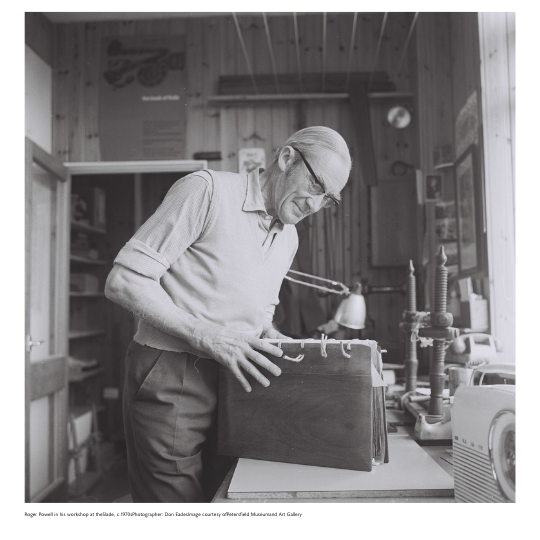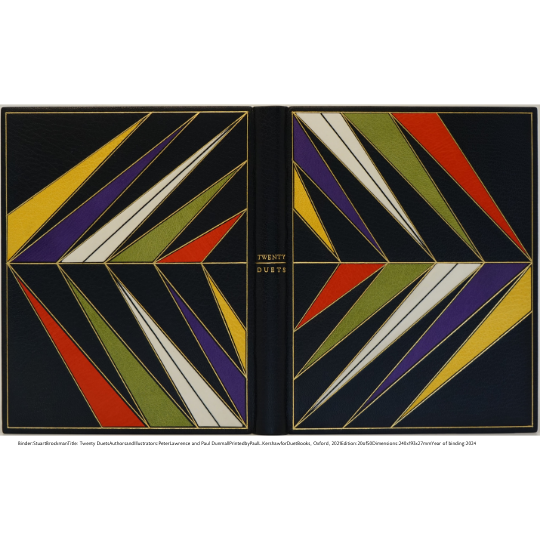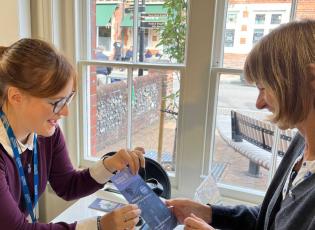Loans will travel to Petersfield from private collections, including the Wormsley Library, and the exhibition will also include more than 20 uniquely bound books by members of Designer Bookbinders.
"This exhibition is inspired by the life of Roger Powell and the fascinating network of connections that can be made between those he studied under, worked alongside and taught, to tell a story of modern British bookbinding. This rich evolution of craftsmanship and artistic expression continues in the work of members of Designer Bookbinders who we are delighted to be working with us to showcase the best in modern bookbinding." Louise Weller, Head of Collections and Exhibitions at Petersfield Museum and Art Gallery
Bound Together will also open a new page for many who might not know about Powell's life, including his school days at Bedales (which was co-founded by his father), his service in the First World War and his passions for beekeeping and golf.
In 1930, at the age of 34, Powell attended the London County Council Central School of Arts and Crafts to study bookbinding under Douglas Cockerell, who had written the technical handbook Bookbinding and the Crafting of Books (1901) for amateurs and librarians, which Powell had received as a boyhood birthday present. A copy of this book will be included in the exhibition.
Powell also studied with William Matthews and included in the exhibition is a student binding of The Jungle Book, on which both teacher and student worked. Matthews was particularly known for his gold tooling and lettering skills, which can be seen in his design for The Book of Psalms, which he bound in 1947 while a tutor at Guildford School of Art. These items will be on display, along with one of the earliest Powell bindings, a book on JS Bach, bound in 1934, presumably as a gift to his parents from their friends Amy and John Badley, co-founders of Bedales.

Powell also bound two volumes of the Bible (1938) dedicated to his parents. Their initials are blind stamped on the inside cover. Visitors will see Powell’s effective use of simple formal elements, including straight lines and geometric shapes, to create striking, elegant designs.
Powell’s interest in understanding the structure of a book or bound manuscript and prioritising the function and durability of his bindings led him being entrusted with the repair and rebinding of religious artefacts of great importance, including the Book of Kells for Trinity College Dublin and The St Chad Gospels for Lichfield Cathedral.
Becoming an expert on medieval manuscripts, Powell also worked on many items for nearby Winchester College and two key examples will be on view. The 14th century Legenda sanctorum by Italian chronicler Jacobus de Voragine was one of the most widely published books of the Middle Ages and features a compilation of over 150 saints and Christian feast days. Bound in alum-tawed pigskin over pasteboard, Powell was working in a tradition that reached back to the Kelmscott Press and beyond to lessons learnt from medieval bookbinders.
While Powell was working in Dublin on the Book of Kells, his bindery was run by his former student Peter Waters and Shelia Waters. Peter Waters became a partner in the business from 1956 to 1971.The exhibition will include several works by the pair who worked in a close and collaborative way. Whilst they both emphasised structure over decorative ambition, it was during this period the workshop produced some of their most striking designs. This includes a 1960s binding of King Lear featuring illustrations by Austrian Expressionist Oskar Kokoschka on loan from the Wormsley Library and a guide to English Blind Stamped Bindings featuring figurative images from blocks made by artist and calligrapher Sheila Waters.
These bindings will be joined by many more rare, creative and delicate examples, from a collection of John Milton’s Poems illustrated by William Blake, bound in 1974, to an edition of The Odyssey, bound in 1977, into four volumes each with a distinct cover and housed in a specially made box by Powell’s friend and renowned designer Edward Barnsley (1900-1987), whose workshop was just half a mile away from Powell’s bindery in Froxfield.
Also on display will be the exquisite calligraphic manuscript by Sheila Waters of Under Milk Wood also from the Wormsley Library. It took Sheila Waters 17 years to write and illustrate the text and was bound by her husband Peter Waters. A facsimile of this book is among the works bound by contemporary bookbinders in the accompanying exhibition of work by members of Designer Bookbinders.

As well as fine bindings, Powell and Waters also focused on conservation and repair work of early printed books and manuscripts. When the River Arno in Florence flooded in 1966, Powell and Waters were integral in the international effort to help conserve and repair thousands of badly damaged books from the Biblioteca Nazionale Centrale di Firenze. The work carried out during this time raised the status of book conservation and led to new international standards. In 1971, Waters left Froxfield to become the first restoration officer at the Library of Congress.
Powell not only worked with numerous apprentices at his bindery, but he also taught at the Central School of Arts and Crafts and the Royal College of Art. His knowledge of his craft and his teaching means his legacy continues to this day, and editions bound by Powell are highly sought after.
Visitors will also be able to get a close-up look at where bookbinding is today, with 20 uniquely bound books by members of the Designer Bookbinders.
Borne out of the Festival of Britain in 1951, which attempted to revive the spirit of the British public following austerity and war through various art forms. Since 1991 the Fellows of the society have been commissioned to bind special editions of the short-listed Man Booker Prize entries which are presented to the authors at the award ceremony.
The range of books that have been bound reflects the diversity of binding styles and designs. Included in the selection is a brightly coloured geometric design by Stuart Brockman for Twenty Duets which riffs on the book’s idea of using Jazz improvisation as a model for wood-engraving, while Kaori Maki’s design for Estuary Poems by Wayland Wordsmith is a poetic design in leather relief that depicts the poet sailing on his boat amongst the constellations.
Pre-book your admission tickets for Bound Together: Modern British Bookbinding or discover What's On at Petersfield Museum and Art Gallery.


